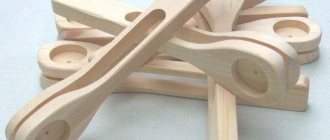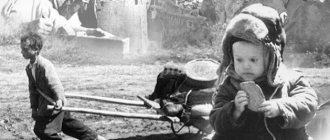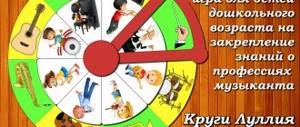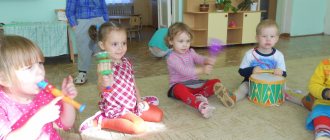Useful skills
Researchers suggest that playing musical instruments and continually developing new mental skills has positive effects.
Restaurants and cafes, fitness clubs and travel agencies will reopen in Moscow
Simple, fast and budget-friendly: we make original furniture out of an old bedside table
The “father effect” is the role of dad in parenting. Being close and raising are two different things
Learning an instrument and playing in a musical ensemble is very difficult. The student must learn to understand and hear music, develop hand-eye coordination and train their hearing. Discipline to practice is also important. All these points play a role in improving the mental abilities and effective functioning of children.
Publication “Playing children's musical instruments in kindergarten, playing techniques”
MADOU "Kindergarten No. 104" Saransk
Children's musical instruments in kindergarten
From early childhood, children are of great interest in the world around them. The sounds of musical instruments for children seem to be something magical, extraordinary, fabulous. If someone in the family plays the piano, violin or guitar, then the little one watches with delight the adults play and tries with all his might to try to do it on his own.
Musical instruments for kindergarten
In preschool institutions, playing children's musical instruments plays an important place in the music director's work with children. The program provides for the beginning of this creative activity already in the younger group, that is, from the second year of life. Children are taught to distinguish and reproduce the high and low sounds of a xylophone, bell, and to distinguish and recognize the sounds of a tambourine, pipe, and drum. In each subsequent group, the tasks become more complicated, the volume of material and the tools themselves are added.
Musical instruments for kindergarten are very diverse. Among them we can distinguish noise and melodic.
Noise instruments include:
Rattles
A musical instrument like a rattle with a pleasant polyphonic sound. Can be used both for folk dances and to decorate melodies and beat out beats. Develops hearing, coordination, sense of rhythm, imagination.
Bells (or wrist bracelets)
The instrument consists of a fabric bracelet and four bells attached to it. Putting the bracelets on your hands, shaking them lightly, alternate fast and slow movements. By changing the strength of the sound, you can create a special flavor, add variety to the familiar sound of various melodies of songs and dances. With the help of bracelets, you can create a musical picture of a winter forest, a troika with bells, or be transported to hot India and turn into a performer of Indian dances.
Playing music bracelets is quite easy; to do this, ask your child to shake his hands at a slow or fast pace. Musical bracelets can also be used when performing various dances. Mischievous parsleys, fairy-tale bunnies, dolls and other characters of the New Year's carnival, participants in a fairy-tale performance, etc. can dance with them. Playing an instrument develops a sense of rhythm, creativity, and motor skills. The instrument allows you to create your own rhythmic pattern, become a member of a musical ensemble or performer in a theatrical performance.
Triangles
It is a steel rod with a diameter of 8-10 mm, bent in the shape of an isosceles triangle, not closed at one of the corners. When playing, the performer holds the triangle in his left hand and strikes different parts of the triangle (to produce sounds of varying degrees of volume) with a special steel stick. The sound of a triangle without a specific pitch, pure and transparent, with a melodic echo that can be drowned out by the touch of a free hand.
Bells
A percussion musical instrument with a certain pitch. The instrument has a light ringing timbre in the piano, brilliant and bright in the forte.
Hand-held musical cymbals
A percussion musical instrument with an indefinite pitch.
Among the main techniques of the game: hitting suspended cymbals with various sticks and mallets, hitting paired cymbals against each other. The sound stops when the musician places the cymbals on his chest.
Musical beaters
A percussion musical instrument consisting of two concave shell plates, connected in the upper parts with a cord. The sound is produced by hitting the palm of the left hand with a mallet.
Diamonds
A children's percussion musical instrument consisting of a wooden hoop, on one side of which a leather membrane is stretched, with metal plates inserted into the slots of the hoop. The musical instrument is used for rhythmic accompaniment of dances, dances, games, and is also used in orchestras and ensembles. Playing an instrument develops a sense of rhythm, creativity, and hand motor skills.
Drums
Wooden spoons
Maracas
It is a round or egg-shaped wooden rattle on a wooden handle, filled with plastic peas. Maracas are very popular in dance music orchestras. The simplicity of playing maracas, their size and weight, allows them to be used with children from 3 to 7 years old.
The correct way to hold a maracas is with one hand and only by the handle. The strength of shaking changes the strength of the sound. Movement of the tool can be vertical and horizontal. Vertical movement gives a louder, stronger sound, horizontal movement gives a quiet rustling sound. Playing an instrument develops a sense of rhythm, creativity, hand coordination, and hand motor skills. The instrument is used for rhythmic accompaniment of folk dances, songs and games, and is used in orchestras.
Rubel
A wooden board with cut-out transverse grooves for rolling linen and rolling leather.
The household item was used for beating and ironing clothes. Hand-wrung linen was wound onto a roller or rolling pin and rolled out with a ruble. The rubel was also used as a musical instrument . When playing, the ruble is held by the handle with one hand, and the other is moved back and forth along its scars with a wooden spoon or stick. This produces a characteristic “crackling” sound.
Ratchets
Russian noise musical instrument. In the Kursk, Tula and Kaluga regions it is a set of oak, maple or walnut planks strung on two straps or laces. The planks do not touch tightly, thanks to wooden spacers inserted between them at the top. The ends of the ratchet straps are taken in both hands (like an accordion), with a sharp (or smooth) movement they hit the strips with their free ends against each other and clicking sounds are obtained.
In the northwestern regions of Russia, a ratchet is a wooden rectangular frame with a toothed shaft that turns into a handle. The grooves between the teeth of the shaft, which serves as the axis of rotation, contain 1-4 elastic strips, attached to the frame with opposite ends. When rotating, the slats forcefully jump from one edge to another, producing a deafening sound reminiscent of machine gun fire.
Melodic instruments:
Metallophones, xylophones
The xylophone is a percussion and pitch instrument. Consists of a set of chromatically tuned wooden blocks. The sound is produced by lightly touching the block with a stick. When playing, the instrument plates should be at knee level if the child is sitting, or at waist level if standing; The child should be comfortable, his hands should move freely.
The basic skills of playing the glockenspiel and xylophone are developed by following these steps:
- familiarization and work with the letter designations of sounds on instrument records
- ability to hold the sticks correctly (do not hold the sticks with your entire palm, do not put your index finger on the stick, do not press the head of the stick against the record while striking)
- mastering various techniques of playing with two hands (joint movement, alternating movement, parallel movement, converging and diverging movement, crossing hands, tremolo, glissando).
Harmonica
A musical instrument of the harmonic family.
It is a small block with many holes on the side. The choice of sounds produced is made by the position of the lips and tongue on the holes, as well as the direction of air movement for inhalation or exhalation.
Pipes
The musical pipe is a tube with playing holes and a whistle device.
Whistles
Electronic piano (synthesizer)
Children play musical instruments with great effort, interest and pleasure. While playing, their musical abilities develop and improve. Kids discover new musical harmonies.
But you shouldn’t think that children’s orchestras are created only in kindergartens and schools. If you wish, you can also organize a small ensemble at home. Let it not be as numerous as in the garden. But it will undoubtedly turn out to be original, sincere and dear. In addition, there is an interesting experience of family education, when parents make children's musical instruments with their own hands. For example, from plastic bottles, jars, dry markers and Kinder surprise boxes you can make maracas, drums, rattles and rustles. And wonderful castanets are made from walnut shells. Even a two-year-old baby can build a musical instrument on his own, using his mother’s pot lids, his father’s fishing bells, or his grandfather’s set of keys. Just use your imagination, and your home will be filled with a huge variety of interesting instruments for a family orchestra. There are no non-musical children. And how musical and talented your child turns out to be depends only on you.
Exam results
To find out, the researchers assessed data from a total of 112,916 Canadian schoolchildren. The children successfully completed the last three grades of high school and took part in central standardized examinations in mathematics, English and science.
According to the research team, about 13 percent of the students surveyed were musically active in school: for example, in the 10th, 11th or 12th grades they played in the school band or sang in the choir. As the assessments showed, these children were especially good at the exams.
An expensive item from Lady Gaga: the singer gave a fan a leather jacket
Strawberry sponge cake dessert with cream: guests will definitely ask for more
The fifth type of matter was created on the ISS




